Truck Accident Statistics

The trucking industry plays an important part in our nation’s economy. Commercial trucks such as 18-wheelers remain the largest transporter of goods in the United States. In 2020, the American Trucking Association reported that commercial trucks transported 10.23 billion tons of freight, amounting to 72.5% of all freight that was transported domestically. The trucking industry also transports about 60% of all freight between the U.S., Mexico, and Canada. These statistics are hardly surprising given the number of trucks on our nation’s roads.
While the trucking industry is needed to transport goods across the country, it also has a responsibility to do so safely. Commercial trucks are involved in thousands of accidents with passenger vehicles each year and because of their size, they are often catastrophic or even fatal.
Commercial Truck Accident Statistics in the United States
- In 2019, there were approximately 510,000 police-reported crashes involving large trucks.
- There were 4,479 fatal truck accidents in 2019, representing 1% of all large truck crashes.
- There were 114,000 injury truck accidents in 2019, accounting for 29% of all truck crashes.
- 82% of truck accident fatalities in 2019 were not the occupants of the large truck.
- An average of 14 people die each day in accidents with commercial trucks.
- An average of 433 people are injured every day in the U.S. in trucking accidents.
- There were 13.65 fatal truck accidents per million people in the United States in 2019, an increase of 29% over 10.6 per million people in 2010.
Fatal Truck Accidents Statistics By State
Below are the 2019 fatal truck accident statistics broken down by state.
Top 10 States with the Most Fatal Truck Accidents
- Texas – 579
- California – 355
- Florida – 311
- Georgia – 180
- Ohio – 152
- North Carolina – 148
- Tennessee – 137
- Pennsylvania – 129
- Alabama – 127
- Illinois – 125
Truck Accident Data from the National Highway Traffic Safety Administration
Per the National Highway Traffic Safety Administration (NHTSA) Traffic Safety Facts, 538,000 large trucks (gross vehicle weight rating greater than 10,000 pounds) were involved in traffic crashes in the U.S. in 2019. That year, large trucks accounted for 4% of all registered vehicles and 9% of total vehicle miles traveled.
Common Truck Crash Characteristics
- In 41% of fatal 2-vehicle crashes involving a truck and another vehicle, both were driving straight.
- In 10% of crashes, the other vehicle was turning left.
- In 10% of crashes, the truck and the other vehicle were navigating a curve.
- In 7% of crashes, the truck was stopped in a lane of traffic.
Most of the fatal accidents involving large trucks occurred in rural areas (57%), during the daytime (64%), and on weekdays (77%). During the week, 72% of the crashes occurred during the daytime (6 a.m. to 6 p.m.). On weekends, 61% occurred at night (6 pm to 6 am). Occupants of the other vehicle made up 71% of the fatalities and approximately 69% of the injuries that resulted from large-truck crashes.
How Do Most Truck Accidents Happen?
Looking at FMCSA truck accident statistics can shed light on how these collisions happen:
- 32% of truck crashes occur outside of the truck’s lane, in other lanes, or off the road.
- About 29% of large truck accidents involve loss of control of the vehicle.
- About 22% of crashes occur when the truck collides with the rear of another vehicle.
Most Common Types of Truck Accidents
Another set of interesting truck accident statistics from the FMCSA addresses the type of collision:
- 73.1% of truck accidents are collisions with another vehicle in motion.
- 9.7% of truck crashes are collisions with fixed objects.
- 8.2% of large truck accidents are collisions with pedestrians.
- Rollover accidents account for 4.2% of trucking crashes.
- 2% involve large trucks striking bicycles, scooters, or the like.
- Collisions with parked vehicles account for just 1.1% of truck crashes.
Truck Accident Statistics: Details & Breakdown
Type of Fatality: Who Was Killed
- Large truck occupants accounted for 10% of fatalities in single-vehicle truck accidents in 2019.
- Large truck occupants accounted for 8% of fatalities in multi-vehicle truck accidents.
- Nonoccupants (pedestrians and cyclists) accounted for 11% of fatalities in truck crashes.
- Occupants of other vehicles accounted for 71% of truck accident fatalities.
Type of Injury: Who Was Injured
- Large truck occupants accounted for 10% of injuries in single-vehicle truck crashes in 2019.
- Large truck occupants accounted for 19% of injuries in multi-vehicle truck accidents.
- Nonoccupants accounted for 3% of injuries in large truck accidents.
- Occupants of other vehicles accounted for 69% of injuries in truck collisions.
Truck Accident Statistics FAQ
Which state has the most truck accidents?
Texas regularly has the highest number of fatal truck accidents of any state in the U.S. each year. In 2017, the Federal Motor Carrier Safety Administration (FMCSA) reported 556 fatal truck accidents in Texas. The state with the second-highest number of fatal crashes was California with 320, followed by Florida with 275.
The FMCSA report also shows the number of fatal accidents involving large trucks, per million people. This shows the accident rate based on each state’s population. Based on these numbers, Mississippi is ranked highest with 31.17 fatal truck accidents per million people. Oklahoma comes in a close second with 30.53 crashes per million people, and Texas is ranked 11th of all states with 19.64 fatal truck accidents per million people.
How many truck accidents happen in the Houston area each year?
According to the Texas Department of Transportation, there were 6,369 total commercial vehicle accidents in Harris County in 2019. This was by far the highest total number of collisions of any county in Texas that year, with Dallas County coming in second with 4,146 accidents.
Of the 6,369 commercial vehicle crashes in Harris County in 2019:
- 33 were fatal crashes, causing the loss of 36 lives
- 110 were classified as “suspected serious crashes,” causing incapacitating injuries
- 409 were classified as “non-incapacitating crashes”
- 1,084 were classified as “possible injury crashes”
Sharing the road with a semi, tanker truck, or tractor-trailer can be an unsettling experience, and if you drive in the Houston area, you should be particularly cautious around these large vehicles.
Who is most likely to be injured in a collision with a large truck?
When a large truck is involved in a collision with another vehicle, the occupants of the other vehicle are most likely to be injured or killed. Truck operators are at a much lower risk of injury. This can be seen by analyzing NHTSA statistics. According to nationwide truck accident statistics from 2017, only 7% of people who lost their lives in multi-vehicle truck accidents were occupants of the truck. Only 15% of people injured in multi-vehicle truck accidents were truck occupants. In comparison, 72% of those killed in truck accidents in the U.S. in 2017 were occupants of other vehicles. 73% of those injured in 2015 were occupants of other vehicles.
As you can see, your chances of being injured in an accident with a large truck are significantly higher than the chances that the truck driver will be harmed. Smaller vehicles stand little to no chance against commercial trucks that may weigh up to 80,000 pounds.
Contact Our Top-Rated Truck Accident Lawyers: (888) 493-1629
The statistics involved in truck accidents are overwhelming. If you or a loved one is injured in an accident, don’t hesitate to talk to a Houston truck accident lawyer from Arnold & Itkin. We have a proven track record of success with trucking accident claims and have obtained billions for clients. Our experience and aggressive tactics can help you combat the trucking companies involved in these accidents and pursue just compensation.
We offer free case reviews, so do not hesitate to fill out one of our online forms today. Call (888) 493-1629 now.
For more information, check out the following blogs:
- Categories


